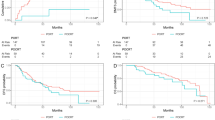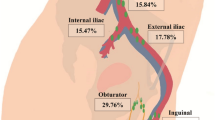Abstract
Background
Pharyngo-laryngo-esophagectomy (PLE) has been regarded as a standard treatment for cervical esophageal cancer, but the morbidity and mortality rates associated with PLE are substantial. Chemoradiation (CTRT) is widely used to treat esophageal cancer; however, its role in managing cervical esophageal cancer has not been fully elucidated. It was hypothesized that up-front CTRT could be an effective alternative treatment option to PLE. The purpose of this study was to compare the outcomes of patients with cervical esophageal cancer treated with these two methods.
Methods
Patients with cervical esophageal cancer from 1995 to 2008 were studied. Three main groups were identified: those treated with PLE, those managed with up-front concurrent chemoradiation, and those not suitable for either PLE or chemoradiation but to whom palliative treatment was offered. The demographics, management strategies, and outcomes of these patients were studied and analyzed.
Results
A total of 107 patients were studied: 87 (81.3%) were men, and the median age was 64 years (range 17–92 years). There were 62 patients who underwent PLE as the primary treatment, 21 had up-front chemoradiation, and the others had palliative treatment. In the PLE group, curative resection was achieved in 37 (59.7%) patients, 20 of whom had either adjuvant chemoradiation or radiotherapy. The hospital mortality rate was 7.1%. In the chemoradiation group, 10 (47.6%) had tumor down-staging, 6 of whom achieved a clinically complete response. Among the 11 patients with poor response, 5 required salvage PLE for palliation. Chemoradiation-associated morbidities included oral mucositis, bilateral vocal cord palsy, esophageal stricture, carotid artery blowout, and permanent hypothyroidism and hypoparathyroidism. The median survival durations of patients in the PLE and chemoradiation groups were 20 and 25 months respectively (P = 0.39).
Conclusions
Up-front chemoradiation can be an alternative therapeutic strategy to PLE. However, this method is not without drawbacks. A significant proportion also requires salvage surgery. Both PLE and chemoradiation have significant curative as well as palliative role in the management of cervical esophageal cancer and treatment should be individualized.




Similar content being viewed by others
References
Ong GB, Lee TC (1960) Pharyngogastric anastomosis after oesophago-pharyngectomy for carcinoma of the hypopharynx and cervical oesophagus. Br J Surg 48:193–200
Wei WI, Lam LK, Yuen PW et al (1998) Current status of pharyngolaryngo-esophagectomy and pharyngogastric anastomosis. Head Neck 20:240–244
Cense HA, Law S, Wei W et al (2007) Pharyngolaryngoesophagectomy using the thoracoscopic approach. Surg Endosc 21:879–884
Law SY, Fok M, Wei WI et al (2000) Thoracoscopic esophageal mobilization for pharyngolaryngoesophagectomy. Ann Thorac Surg 70:418–422
Law S, Fok M, Chu KM et al (1997) Thoracoscopic esophagectomy for esophageal cancer. Surgery 122:8–14
Smith TJ, Ryan LM, Douglass HO Jr et al (1998) Combined chemoradiotherapy vs. radiotherapy alone for early stage squamous cell carcinoma of the esophagus: a study of the Eastern Cooperative Oncology Group. Int J Radiat Oncol Biol Phys 42:269–276
Herskovic A, Martz K, al-Sarraf M et al (1992) Combined chemotherapy and radiotherapy compared with radiotherapy alone in patients with cancer of the esophagus. N Engl J Med 326:1593–1598
Al-Sarraf M, Martz K, Herskovic A et al (1997) Progress report of combined chemoradiotherapy versus radiotherapy alone in patients with esophageal cancer: an intergroup study. J Clin Oncol 15:277–284
Wittekind C, Compton CC, Greene FL et al (2002) TNM residual tumor classification revisited. Cancer 94:2511–2516
Lee DJ, Harris A, Gillette A et al (1984) Carcinoma of the cervical esophagus: diagnosis, management, and results. South Med J 77:1365–1367
Arriagada R, Eschwege F, Cachin Y et al (1983) The value of combining radiotherapy with surgery in the treatment of hypopharyngeal and laryngeal cancers. Cancer 51:1819–1825
Orringer MB (1992) Anterior mediastinal tracheostomy with and without cervical exenteration. Ann Thorac Surg 54:628–636 discussion 636–627
Wong SK, Chan AC, Lee DW et al (2003) Minimal invasive approach of gastric and esophageal mobilization in total pharyngolaryngoesophagectomy: total laparoscopic and hand-assisted laparoscopic technique. Surg Endosc 17:798–802
Cooper JS, Guo MD, Herskovic A et al (1999) Chemoradiotherapy of locally advanced esophageal cancer: long-term follow-up of a prospective randomized trial (RTOG 85-01)—Radiation Therapy Oncology Group. JAMA 281:1623–1627
Wang S, Liao Z, Chen Y et al (2006) Esophageal cancer located at the neck and upper thorax treated with concurrent chemoradiation: a single-institution experience. J Thorac Oncol 1:252–259
Uno T, Isobe K, Kawakami H et al (2007) Concurrent chemoradiation for patients with squamous cell carcinoma of the cervical esophagus. Dis Esophagus 20:12–18
Law S (1999) Chemoradiotherapy: panacea for esophageal cancer? Commentary for chemoradiotherapy of locally advanced esophageal cancer: long-term follow-up of a prospective randomized trial (RTOG 85-01). JAMA Southeast Asia 15:9–11
Greene FL, Page DL, Fleming ID et al (eds) (2002) AJCC cancer staging manual: American Joint Committee on Cancer, 6th edn. Springer, New York
LeQuesne L (1966) Pharyngolaryngectomy, with immediate pharyngogastric anastomosis. Br J Surg 53:105–109
Lam KH, Wong J, Lim ST et al (1981) Pharyngogastric anastomosis following pharyngolaryngoesophagectomy: analysis of 157 cases. World J Surg 5:509–516
Spiro RH, Shah JP, Strong EW et al (1983) Gastric transposition in head and neck surgery: indications, complications, and expectations. Am J Surg 146:483–487
Harrison DF, Thompson AE (1986) Pharyngolaryngoesophagectomy with pharyngogastric anastomosis for cancer of the hypopharynx: review of 101 operations. Head Neck Surg 8:418–428
Lam KH, Choi TK, Wei WI et al (1987) Present status of pharyngogastric anastomosis following pharyngolaryngo-oesophagectomy. Br J Surg 74:122–125
Mehta SA, Sarkar S, Mehta AR et al (1990) Mortality and morbidity of primary pharyngogastric anastomosis following circumferential excision for hypopharyngeal malignancies. J Surg Oncol 43:24–27
Spiro RH, Bains MS, Shah JP et al (1991) Gastric transposition for head and neck cancer: a critical update. Am J Surg 162:348–352
Cahow CE, Sasaki CT (1994) Gastric pull-up reconstruction for pharyngo-laryngo-esophagectomy. Arch Surg 129:425–429 discussion 429–430
Bardini R, Ruol A, Peracchia A (1995) Therapeutic options for cancer of the hypopharynx and cervical oesophagus. Ann Chir Gynaecol 84:202–207
Hartley BE, Bottrill ID, Howard DJ (1999) A third decade’s experience with the gastric pull-up operation for hypopharyngeal carcinoma: changing patterns of use. J Laryngol Otol 113:241–243
Triboulet JP, Mariette C, Chevalier D et al (2001) Surgical management of carcinoma of the hypopharynx and cervical esophagus: analysis of 209 cases. Arch Surg 136:1164–1170
Pesko P, Sabljak P, Bjelovic M et al (2006) Surgical treatment and clinical course of patients with hypopharyngeal carcinoma. Dis Esophagus 19:248–253
Author information
Authors and Affiliations
Corresponding author
Rights and permissions
About this article
Cite this article
Tong, D.K.H., Law, S., Kwong, D.L.W. et al. Current Management of Cervical Esophageal Cancer. World J Surg 35, 600–607 (2011). https://doi.org/10.1007/s00268-010-0876-7
Published:
Issue Date:
DOI: https://doi.org/10.1007/s00268-010-0876-7




